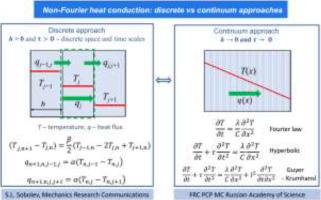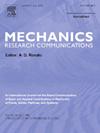非傅立叶热传导:离散与连续方法
IF 2.3
4区 工程技术
Q3 MECHANICS
引用次数: 0
摘要
在远离局域平衡的条件下,即在超短的空间和时间尺度上,热传导过程固有的非局域性开始发挥关键作用。离散变量模型(DVM)假设时间和空间是离散变量,是描述非局部效应最有效的方法之一。在DVM的框架下,建立并分析了热传导方程、能量守恒定律和热流本构方程。与连续介质方法的预测相比,DVM在超短时间和长度尺度上预测离散热方程的光谱特征中具有相当不寻常的行为。这种不寻常的行为可以作为高频热流机制的新实验研究的指导,观察固体和热材料中的新物理现象,以扩大其技术应用的范围。为了弥合离散和连续方法之间的差距,连续化过程中使用了两个不变量,即热扩散率和温度扰动的传播速度。在连续介质极限下,离散热方程包含了一个无限层次的偏微分方程,包括经典的傅立叶、双曲、盖耶-克鲁姆汉斯和杰弗里斯热传导方程。将DVM推广到二维和双温度的情况。讨论了离散方法在纳米系统和超材料热传导中的可能应用。本文章由计算机程序翻译,如有差异,请以英文原文为准。

Non-Fourier heat conduction: Discrete vs continuum approaches
Under far from local-equilibrium conditions, that is on ultra-short space and time scales, the inherent non-locality of the heat conduction process begins to play a crucial role. The discrete variable model (DVM), which assumes that time and space are discrete variables, is one of the most effective approaches to describe the nonlocal effects. Heat conduction equation, energy conservation law, and constitutive equation for the heat flux have been formulated and analyzed in the framework of the DVM. The DVM predicts rather unusual behavior in the spectral characteristics of discrete heat equations on ultrashort time and length scales compared to predictions of continuum approaches. This unusual behavior may serve as a guide for new experimental investigations of high-frequency heat flow regimes, observation of new physical phenomena in solid and thermal materials to expand the range of their technological applications.
To bridge the gap between the discrete and continuum approaches, two invariants for the continualization procedure, namely, thermal diffusivity and propagation velocity of temperature disturbances, have been employed. It has been demonstrated that in the continuum limit the discrete heat equation contains an infinite hierarchy of partial differential equations including classical Fourier, hyperbolic, Guyer-Krumhansl and Jeffreys heat conduction equations. Generalizations of the DVM to two-dimensional and two-temperature cases have been considered. Possible applications of the discrete approach to heat conduction in nano systems and metamaterials have been discussed.
求助全文
通过发布文献求助,成功后即可免费获取论文全文。
去求助
来源期刊
CiteScore
4.10
自引率
4.20%
发文量
114
审稿时长
9 months
期刊介绍:
Mechanics Research Communications publishes, as rapidly as possible, peer-reviewed manuscripts of high standards but restricted length. It aims to provide:
• a fast means of communication
• an exchange of ideas among workers in mechanics
• an effective method of bringing new results quickly to the public
• an informal vehicle for the discussion
• of ideas that may still be in the formative stages
The field of Mechanics will be understood to encompass the behavior of continua, fluids, solids, particles and their mixtures. Submissions must contain a strong, novel contribution to the field of mechanics, and ideally should be focused on current issues in the field involving theoretical, experimental and/or applied research, preferably within the broad expertise encompassed by the Board of Associate Editors. Deviations from these areas should be discussed in advance with the Editor-in-Chief.

 求助内容:
求助内容: 应助结果提醒方式:
应助结果提醒方式:


